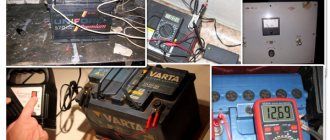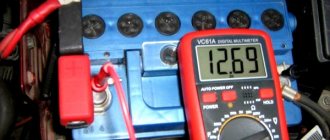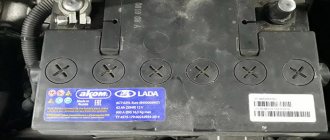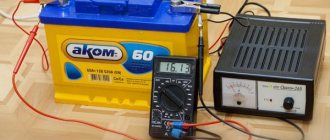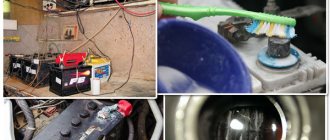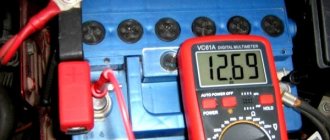The battery is the most important thing in any car. It is this element that provides the starting current to the starter. It is thanks to the battery that the engine starts quickly and without problems. But this doesn't always happen. To avoid difficulty starting, you need to periodically check its charge level. There are several ways to do this.
How to check the charge of a car battery at home? You will find out the answer to this question further in our article.
Make sure the battery is low
Several ways to understand that the battery is not charged:
- look at the indicator (red means the battery needs to be charged);
- use a multimeter (charged battery voltage at the terminals is not lower than 12.6 V);
- The load plug will show the voltage drop under load.
Battery charge rate
One of the main parameters of the condition of a car battery is voltage. Using voltage, a certain battery charge level is checked. Therefore, the car owner needs to know what the normal value of the battery voltage is.
The normal voltage of a six-cell battery in a charged state is 12.6-12.9 volts. That is, the voltage of one fully charged element is 2.1─2.15 volts. A lower value indicates that the battery is low.
But that doesn't mean it can't be used. Ideally, of course, you need to keep the battery fully charged. But in practice, this can only be done if the battery is fully charged and then a current equal to self-discharge is applied to the terminals. So the battery is rarely in a fully charged state. Below you can see the relationship between voltage and battery charge level.
Follow safety precautions
Almost everyone understands that you should not unscrew a hot battery with your bare hands. But not everyone knows that the battery contains poisons. The battery contains toxic substances: sulfuric acid, lead, arsenic, hydrogen. It's easy to find information about them.
Below are tips that we strongly recommend following when working with the battery:
- Manipulations with the battery must be carried out in a ventilated non-residential area;
- the ambient temperature where you are working with the battery must be at least +10 °C (if the battery is from the cold, then first it must be allowed to warm up);
- work only in rubber gloves and safety glasses, the skin should be covered with clothing (drivers often do not pay attention to such recommendations, thereby exposing themselves to the risk of, for example, getting a chemical burn);
- you cannot pour water into the acid, you can only do the opposite (otherwise there will be a strong reaction with the release of heat, which can lead to trouble);
- You cannot smoke, light anything, or use devices that produce sparks (the battery produces gases that can ignite);
- this advice is related to the previous one: be sure to let the gases evaporate before charging the battery in order to minimize possible risks;
- After handling batteries, be sure to wash your hands with soap and warm water.
Where to charge?
Many people do not give due importance to this aspect of the car battery charging process. And in vain, because under no circumstances should you charge the battery in a poorly ventilated area, especially if we are talking about an apartment. The fact is that during the charging process the battery emits sulfur dioxide, arsenic hydrogen (arsine), antimonous hydrogen (stibine), hydrogen chloride and other toxic substances. Their high concentration is harmful to humans, causing headaches, coughs and other symptoms of deterioration of health. Moreover, everything that the battery emits ends up on furniture, clothes, and carpets. Consequently, these poisons will have their negative impact on humans for a long time.
Do you think this is nonsense? In order to prove the opposite, we conducted a visual experiment, may Green Peace forgive us. Next to the battery, which is being charged in an unventilated room, we placed a small indoor tree. Lively, green and very pretty. After just a few hours, its leaves began to dry out and turn yellow, and after another two hours, only the trunk and branches remained of the tree. All the leaves have fallen. Draw your own conclusions.
However, that's not all. The hydrogen released by the battery combines with the oxygen contained in the air to become explosive. Sometimes all it takes is a small spark, a lit match or a cigarette. Therefore, the safest place to charge a car battery is outside or in a well-ventilated room, preferably with a draft.
In conclusion, we would like to wish that the battery in your car never runs out.
March 19, 2013. Artem Kiselev, especially for InfoCar.ua
Source: InfoCar.ua
Original taken from
lukilukii
in Car Battery. Charging correctly
A. LAVRENOV, Irkutsk
When a battery (or rechargeable battery) is charged, the charging current is set according to the readings of the ammeter. What does it show?
Electrochemical processes in a battery occur on the surface of its plates, which are in the electrolyte. To increase the battery capacity, the plates are made porous. In the thickness of the plate, in its pores, mixing of the electrolyte occurs much more slowly than on its surface and in the adjacent electrolyte layer.
It has been noticed that the higher the charging current, the more intense undesirable processes occur in the thickness of the plates, i.e., battery aging. Therefore, the charging current is limited, finding a compromise between charging speed and the rate of battery aging from high current. It is generally accepted to charge lead-acid starter batteries with a current equal in amperes to one-tenth of the ampere-hour capacity. And the operating instructions for these batteries [1] recommend, for example, for a 6ST55 battery the charging current is even less - 2.75 A, i.e. 0.05 capacity.
For many years, chargers have been manufactured according to the same structural diagram: mains transformer—full-wave rectifier (sometimes bridge)—rheostat—ammeter. Let's add a measuring resistor with a resistance of 0.1 Ohm to the charging circuit of the device, and instead of one ammeter we will connect three in series - a magnetoelectric (TL-4 avometer), an electromagnetic E421 and a M890F multimeter (see diagram in Fig. 1). We will set the avometer and multimeter to measure direct current.
Let's connect the battery to the charger and use the magnetoelectric ammeter PA1 to set the charging current with rheostat R1 to 1.9 A. Some may find it strange, but the electromagnetic ammeter PA2 will show 2.7 A, and the electronic ammeter will show 1.87 A. All devices tested and gave the same readings when measuring direct current.
The slight difference in the readings of ammeters PA1 and RAZ is explained only by the natural error of the instruments, but the reason for the significant difference in the readings of ammeter PA2 is that the current in the circuit is very different from constant. It is known that the ammeter of the electromagnetic system measures the effective value of alternating current, and the magnetoelectric and electronic ones measure the average. It is the average value of the charging current that determines the electrical charge transferred to the battery.
Let's apply the voltage dropped across the measuring resistor R2 to the Y input of the oscilloscope (sweep speed - 2 ms/div, sensitivity - 0.2 V/div) and take a series of oscillograms at current values of 1, 2 and 3 A, set using an ammeter TL-4.
The oscillograms (Fig. 2, a, b and c, respectively) strongly resemble in shape the voltage at the output of a half-wave rectifier, although each “half-sine wave” is somewhat distorted: its top is flattened at the top and inclined to the right. The charging current occurs at the moment when the voltage at the output of the rectifier exceeds the EMF of the battery being charged, while the electrochemical processes are nonlinear. Connecting a smoothing capacitor C1 with a capacity of 4700 μF to the output of the rectifier practically did not change the shape of the charging current. And here’s the most interesting thing: these “half-sine waves” on the oscillogram in Fig. 2b, for example, have a height at the maximum point of two divisions of the oscilloscope scale, and this corresponds to 4 A. Do you remember what the ammeters showed?
Let's now experiment with an SCR charger. Such devices are attractive because, due to the absence of a bulky, powerful rheostat, they are small in size and have significantly higher efficiency and reliability. For the experiment, I chose the device described in [2]. The voltage of the secondary winding is 27 V rms, the ammeter is left alone - TL-4, the measuring resistor with a resistance of 0.1 Ohm is the same.
Oscillogram in Fig. 3a corresponds to the ammeter reading of 1 A; the current amplitude reaches 3.2 divisions of the oscilloscope scale - 6.4 A. Oscillograms Fig. 3, b and 3, c - with ammeter readings also 2 and 3 A. Curves 2, c and 3, c are close to each other in amplitude, since the same transformer was used, the rheostat was in a position where the resistance was almost minimal, and the trinistor is open almost the entire half-cycle.
Charging process (step by step instructions)
The process itself is simple: connect the charger wires to the battery terminals, observing the polarity (plus to plus, minus to minus) and insert the plug into the socket.
It is important to understand that there are two methods: direct current charging (do not remove the battery) and constant voltage charging (remove the battery).
Charging with direct current is more efficient, is carried out in several stages, and requires control. This method is more difficult. The process itself is like this:
- we charge the battery with a current that is 10% of the total capacity of the battery (if the capacity is 60A/h, then we charge no more than 6 A), wait until the voltage at the terminals is 14.3-14.4 V;
- to reduce boiling, the next step is to continue charging, reducing the current by 2 times (in this example to 3 A);
- The result is a full charge in approximately 10 hours.
Constant voltage charging is easier, but only provides 80% charge. The voltage is kept between 14-16 V. The current gradually decreases as the battery charges. Here the algorithm looks like this: set the voltage in the range of 14.4-14.5; We wait a day, we get the battery charged to 80%.
How to charge?
Chargers for car batteries today are presented in huge quantities - from cheap Chinese ones to fully automatic, high-quality, but expensive ones from famous manufacturers. To choose the “right” charger, it is better to consult with a specialist, but it is still worthwhile to navigate the basic selection criteria. Moreover, there are not so many of them.
The first thing you need to pay attention to is the charging circuit, since some devices operate with a constant current value, while others operate with a constant voltage value. In practice, this means that a constant current charger will fully charge the battery, but may overheat the electrolyte, which will shorten the battery life. A constant voltage charger, in turn, eliminates the risk of electrolyte overheating, but will not charge the battery completely, since the current will drop at the end of the charging cycle. But don’t rush to get upset. There are also so-called chargers with a combined charge cycle, which first charge the battery at a constant current, and then the voltage stabilizes and the current drops. The entire process occurs automatically and does not require any attention. Naturally, such chargers are the most expensive.
Note! When choosing the power of the charger, you need to take into account the fact that the maximum recommended battery charging current corresponds to 10% of its capacity. For example, with a capacity of 65 Ah, it is equal to 6.5 A.
The next selection criterion is pulse or transformer memory. Transformer is considered very reliable, but is unlikely to please with its dimensions and weight. Pulse ones are more compact and lighter, while reliability very much depends on the manufacturer.
Well, the third criterion for choosing a charger is the power supply method. There are two options here. The first, classic, in which the charger itself is connected to the network, and the current is transmitted to the battery through “crocodiles”. The second is more sophisticated, but not always applicable, since much depends on the characteristics of a particular car. We are talking about so-called charging and starting devices that charge the battery through the cigarette lighter. The main thing is that the cigarette lighter is powered directly from the battery and not through a generator. Moreover, the charging and starting devices themselves are divided into several more categories - those that operate from a 220V network, those that can operate from the cigarette lighter of another car, and also those that have their own batteries, that is, an autonomous power source.
How long to charge the battery
The battery recharging time depends on several factors: the type of device and the amount of current. Less current means more time to recharge.
It takes 15 minutes for the battery to start the engine. Then you need to drive around until the battery is fully charged, while it is recommended to use additional devices that consume current (stove, radio, etc.) to a minimum.
So how long does it take to charge the battery? It takes 10-12 hours to charge the battery.
Causes and solutions to the problem
If you have the opportunity to borrow someone else’s battery for testing, you can try installing it in the car instead of yours. Of course, this battery must be fully working. Actually, in this way you can find out what the cause of the problem is - in the battery or in the generator. Below we will consider the reasons for this malfunction.
Internal condition of the battery
Typically, the reason why the generator cannot charge the battery is due to sulfation of the battery plates. In this case, the surface of the plates may be covered with salts - partially or completely - which prevent the battery from charging. If the degree of plate coverage is small, then, in principle, you can always try to restore the functionality of the battery. However, if the destruction process is no longer reversible, it will be necessary to replace the device.
As for restoring the battery structure from sulfation, this process can take more than one day, and the result and quality of restoration cannot be guaranteed. This means that you may eventually need a new battery anyway. The resuscitation procedure, as a rule, begins when the battery shows no signs of swelling, mechanical damage, cracks, etc. That is, the device body must be intact.
Installing battery terminals to terminals
But it should be borne in mind that the external state is not always a guarantee that the result will suit you. Inside the structure there are banks in which plates can break off, which ultimately leads to a short circuit. If this is the case, then there are no other options other than buying a new battery.
Terminals
Sometimes the indicator light may appear while driving a car. At this moment, you should not panic, as the reason may be quite banal. If you hit a bump or a hole, the contact may simply fall off the battery, especially if the terminal was not screwed on properly. If this is the case, then you just need to put it back in place and tighten it harder.
Problems with terminals can occur if they become oxidized at the point where they connect to the terminal. To solve this problem, the oxidation simply needs to be cleaned up. To do this you will need fine grit sandpaper. You need to be as careful as possible during the process, since you can accidentally cut off the lead part of the terminal, and this is unacceptable. If you erase more layers than necessary, the terminal will not hold well and will begin to fall off on every bump (video author - Avramenko Garage).
Generator belt
What charge should the generator provide and for what reasons does the battery overcharge or fail to charge? Quite often, the problem lies in the strap of the unit - if the tension is weak, the belt will begin to slip on the shaft, at this moment the unit will not be able to supply voltage to the system. The battery is switched and the charged battery turns from an energy consumer into a source of consumption, which is gradually discharged.
Diagnostics of the degree of belt tension can be carried out with the engine turned off. If the internal combustion engine is disconnected, you can try to tighten it if necessary. But it should be borne in mind that slippage can be caused not only by poor tension, but also by profile wear. This problem can only be solved by replacing the strap.
A wet or damp shaft can cause the impossibility of transmitting rotation - the strap will slide over the surface without effort. In order for the battery to charge normally, the pulley must be dry, so it will only be enough to dry it. It is quite difficult to determine slippage; in this case, the strap may break.
The cause of the problem may be oxidation of the wires on the generator unit at the connections. If you notice a white coating, then, as stated above, it can be removed with sandpaper. Carry out a visual check for possible broken wires or burnt contacts. If the wire is burnt out, this may be indicated by a characteristic smell (the author of the video is VAZ 2101-2107 REPAIR AND MAINTENANCE).
Emergency measures for charging the battery in winter
In the cold season, a situation may arise when the battery “died”. In this case, we recommend removing the battery and moving it to a warm place for half an hour.
Read also: Biryusa refrigerator does not turn off and works constantly
You can speed up the process by placing the battery in slightly warm (this is a prerequisite) water. The terminals must remain dry. This is a dangerous method and may shorten the life of the battery. If, for example, the water is too hot, the electrolyte will expand.
Using household appliances such as hair dryers and heaters inappropriately can damage the battery.
What is a battery and why is it needed?
This device is a device that acts as a “storage” of energy, and it is stored in chemical form; it can subsequently be used to power machine systems. This can happen when two different metals in an acid solution begin to produce electrical voltage.
A battery is needed in a car to start the engine and power various electronic equipment, which is becoming more and more common on modern cars. This device is recharged from a generator while the car is moving, but periodically, especially in cold weather, it needs to be charged with a stationary charger.
During the operation of the vehicle, the battery, like other units, requires systematic monitoring and maintenance. You should monitor the electrolyte level in the battery banks and also check its density. For the central regions of the Russian Federation and most CIS countries, its value should be equal to 1.27 g/cm3
. For areas with cold climates, it should be slightly higher, otherwise there will be difficulties starting the engine in cold weather.
Lighting a cigarette from a charged battery
The most popular way to “reanimate” a battery. When connecting batteries to each other, remember the diagram:
- We connect the wire for lighting one end to the positive on the operating unit;
- with the other end we also connect it to the positive on the non-working battery;
- with the second wire we do the opposite (first we connect the wire to the negative of the failed battery, and then we connect to the negative of the charged battery).
Low Battery Syndrome
New phone battery won't charge? Let's figure it out. In any phone there is a special controller that will refuse and prohibit charging a battery whose voltage has dropped below 3.5 V. Therefore, you should not frantically run around and buy a new battery if it does not want to charge, it is quite possible that it has been discharged too much. The native charger will not help in this case; we need another power source.
Using a device with free terminals
A universal solution can be considered a “frog”. This is a charger with free terminals, you can connect almost any battery to it. It is unlikely to fully charge a serious battery, but we don’t need this, we need to bring the voltage on the battery above 3.5 V. If there is no frog nearby, then you can use any other charger, having previously calculated what current strength we need will be needed, and by creating additional resistance if necessary. We will not go into details; the average user is unlikely to be able to do this, and those who are capable do not need instructions. In any case, it would be nice to have a multimeter with you, we charge our battery in any available way and measure the voltage on it. If you don’t have a multimeter, let’s charge the battery for a decent period of time, after which we experimentally check whether our beauty has “come to life”.
In most cases, the phone will boot with a restored battery, but it may not charge. In which case? Again, we check the current strength on the charger that we connect to the phone. If the ampere is not enough, we replace it with a suitable one that matches our original charger.
If the problem is not solved, then it’s time to check the iron for conductivity. We disassemble the phone, we need to get to the USB port and ring it. You can't do without a multimeter here. We lean the minus against the port casing, and the plus against the capacitor, as shown in the figure.
Checking the USB port with a multimeter
If the current does not pass, you will have to replace the port yourself or contact a service center. In principle, there is no point in climbing further on your own, so we will stop here.
Moving the battery to your home
It happens that a driver rarely drives a car in winter. In this case, experienced drivers strongly recommend removing the battery and storing it in a dry, warm room. The recommendation is supported by the fact that a non-working battery at low temperatures quickly deteriorates in its characteristics. Sometimes this even leads to irreversible damage to the battery.
During such storage, it is important not to forget to charge the battery at least once every 3 months. Then he will always be in “combat” readiness.
In conclusion, we emphasize: be attentive to the car and to yourself. Many unpleasant situations will not happen if you think about your safety in advance. Proper use of the battery will allow you to avoid malfunctions. Careful preparation of the car before a long journey will allow you to get to your intended destination without unnecessary incidents.
What to do if the battery charge is not normal?
The answer to this question is simple. If the battery charge is not normal, the battery needs to be charged. The charging process was described in detail in the article “How to properly charge a car battery with a charger.” Here I would like to note some nuances.
- accelerated This mode is often called Boost and can be found on many modern chargers (chargers). In this mode, the battery charge is not fully charged, but it is quite enough to start the engine. This type of charging is used when you need to go urgently and the battery is low. This mode is not recommended to be used continuously. Here, the charge is accelerated by increasing the current strength, which increases the battery life;
- with constant voltage. This type of charging involves maintaining a constant voltage across the terminals. This mode is used in the automatic charge mode on most chargers. It is recommended to use it when the battery is not very discharged (not lower than 12 volts). Read more about car battery voltage in the article at the link. The advantage of this mode is that you don't have to control it. The charger itself will determine when the charge is normal and stop the process;
- with direct current. This charging option involves supplying constant current to the battery. The process is carried out in several stages, in which the current gradually decreases. This mode is recommended when charging a deeply discharged battery. It allows you to charge the battery most fully and evenly. The downside is that you will have to constantly monitor the process, measure the voltage and stop the process when the battery charge is normal.
Battery charging process
In conclusion, I would like to remind you about the safety rules when charging a battery. The process must be carried out in a ventilated area. It is better not to charge in residential areas. There should be no open flames or sparks near the battery being charged. During the charging process, hydrogen is released, which in combination with oxygen forms an explosive mixture!
Try our service station selection service
Creating an application is absolutely free and will take you no more than 5 minutes
- How to determine if the battery is charged
- How to check your phone battery
- How to calculate battery capacity
- How to determine if the battery is charged
The battery plays an important role in a car. When you turn the ignition key, it sends current to the starter. It helps the engine start. If it is discharged, you will not be able to start the car.
Therefore, to avoid problems with starting, this is especially important in winter, it is necessary to periodically monitor the battery capacity. Because With the onset of winter, many car owners are faced with this. This is due to the fact that negative temperatures have a bad effect on the electrolyte. at how to check the charge of a car battery at home below.
Electrolyte
There is another way to check the charge of a car battery with your own hands. It is especially relevant on the eve of winter. As is known, with a drop in temperature, the density of the electrolyte decreases. Accordingly, the charge and performance of the battery decreases. How to check the charge of a car battery? For this we need a hydrometer. Below are detailed instructions:
- So, open the hood and, using a negative screwdriver, unscrew the battery “banks” one by one. There are only 6 of them.
- We immerse our hydrometer inside and wait until it is filled with electrolyte.
- Next, we take the device out and look at the readings.
- After a short time, the float will float to the desired level. There will be several divisions on the scale. A figure of 1.23-1.27 grams per cubic centimeter is considered normal. If the electrolyte density is 1.2 grams, then the battery is about a quarter discharged. A deep discharge is indicated by a reading of 1.1 or less grams per cubic centimeter.
It is also worth checking the electrolyte level itself in each of the “cans”. If it is insufficient, it should be renewed. This can be done with distilled water (coolant is also diluted with it).
Do not ignore insufficient electrolyte level in the battery. This can cause frequent loss of charge and shedding of lead plates. As a result, the battery will become unusable, and during any attempts to recharge, the liquid will boil.
How to properly test a car battery for performance
How to check a car battery?
The voltage of a fully charged car battery must be at least 12.6 volts. If the voltage is less than 12 volts, the degree of charge has dropped by more than 50%, then it urgently needs to be charged!
Deep discharges of the battery should not be allowed; this leads, I repeat once again, to sulfation of the plates. A battery voltage of less than 11.6 V means that it is 100% discharged.
Ways to check the condition of a car battery:
Each of these methods has its own subtleties and nuances. Now let’s take a closer look at how to check your car’s battery for performance with your own hands.
An alternative to connecting an ammeter in a car (clamp clamp)
As a conclusion, we will briefly consider how you can do without building in an ammeter (since it is not so easy to do) and measure the currents of interest to us. To measure leakage currents, a conventional multimeter is sufficient. For other measurements you will need a current clamp. Of course, their cost will make few people happy, but believe me, a good quality ammeter with a shunt for a car will cost no less.
To measure leakage currents, you need to turn the multimeter into ammeter mode with a limit of up to 10 A, not forgetting to move the positive probe into the corresponding connector on the device. The ammeter is connected to the gap between the battery and one of the terminals disconnected from it. The device readings are the leakage currents. Attention! Carry out the described procedure only with the engine and electrical consumers turned off. It is absolutely forbidden to start the engine or turn on a powerful load (headlights, external acoustics, stove) while the ammeter is in the circuit.
Well, to measure the cold cranking current (starter inrush current), battery charge and discharge, and energy consumption of devices, it is enough to buy current clamps. They are very easy to work with. Using pliers you need to cordon off the wire through which the currents of interest flow. For example, to measure the starting current, the clamp is installed on the positive wire going to the starter. The remaining parameters can be measured by installing the device in places where the current shunt is installed using the methods described in the article.
How to check the car battery charge using the indicator
Currently, many batteries are equipped with a built-in indicator indicating its current condition. Japan was the first to use it in battery production.
There is a special window on the battery cover. This is the car battery charge indicator. It is also called a hydrometer. Usually has a green color , indicating that it is completely infected. As the discharge progresses, the color changes. If the color is white or gray, this is a signal that part of the capacity has been lost. This means it needs to be charged. If the color is black , this means that it is completely discharged and needs to be replaced .
The principle of its operation is as follows:
- As the charge level of a car battery increases, the density of the electrolyte increases. Which in turn leads to the fact that the float, in the form of a green ball, rises through the tube and becomes visible in a special window. The float floats up when the battery charge is 66% or higher.
- If the float does not float up, then the condition of the car battery is below normal. As noted, the window will be black, but some have another red ball that will pop up when the battery charge is low.
- If the electrolyte level in the battery is low (partial loss of capacity), the electrolyte itself will be visible through the eye. In such a situation, it is necessary to add distilled water and recharge it.
Read also: Chain wrench for removing the oil filter
How to check a battery when buying it in a store or by hand? You can also determine the health of a car battery using the indicator - a fairly simple and easy way .
However, it is worth remembering that the indicator makes it possible to make a preliminary assessment of the degree of charge, but not an accurate one. And you should not fully rely on his testimony; there are more accurate methods. In addition, such a check is not possible with all batteries; some are not equipped with this window. Therefore, it is important to be aware of other methods.
How to use the battery correctly
You can delay car battery repairs and extend its service life by following simple rules:
- at least once a season it is necessary to monitor the density of the electrolyte;
- during frosts above 20-25 C, it is necessary to bring the density to 1.35-1.4 g/ml;
- to charge the battery, a current strength is used that is 10 times less than the numerical value of the capacity;
if the car may end up in an open parking lot during frosts of -25 C, then it is advisable to cover it or take it with you so that the frozen electrolyte does not damage the unit.
Not every car enthusiast knows how to restore a car battery. And this can extend its life for several years and protect the car owner from unexpected financial expenses. Today, there are four main ways to extend the life of any battery.
The battery is responsible for the process of continuous supply of the required voltage. Accordingly, they are an indispensable component of the operation of certain mechanisms of the machine and its devices. Everyone knows that nothing lasts forever. As a result, every car needs regular technical inspections in order to identify unusable parts. As a rule, any battery (the most common are acid-alkaline and lithium) can be repaired. This option is better than immediately running to the store for a new one.
As for acid-base (they are also called lead-helium), their structure is presented as follows - a pair of “plus-minus” plates made of lead in sulfuric acid. They are the most common in the automotive industry and in the production of flashlights. However, such a battery does not last long.
The first way to restore batteries is to use repeated charging using a low current. In this case, the charging process must provide time intervals between recharges. Thus, starting from the first recharge and ending with the last, the voltage in the battery gradually increases and, as a result, it will stop accepting the charge itself.
Pauses are necessary so that the potentials of the electrodes located deep in the mass of the plates themselves and on their surface are leveled, which makes restoration safer. In parallel, the densest electrolyte begins to flow directly from the pores of the plates themselves into the space located between the electrodes.
Along with the cyclic charge and along with the increase in battery capacity, the density of the electrolyte itself also increases. It is necessary to wait until the section voltage is equal to two and a half volts, and the density indicator reaches a normal level. Only then should the car battery “rest”. This cycle should be repeated up to eight times. Also, the charge current itself must be exactly ten times less than the capacity of the battery being charged.
How to check the charge of a car battery with a multimeter
A multimeter is a special device that is used to measure voltage in a network. An important tool that any driver must have. The price of the device is not high. We recommend using those equipped with an electronic scoreboard.
How to properly check the charge of a car battery using a multimeter? To do this, follow these steps:
- Connect the multimeter wires.
- Set the multimeter to voltage measurement mode and set it to 20 Volts.
- Metal wire probes are applied to the battery terminals. (Red probe to the positive terminal, black to the negative terminal).
- See the readings.
Very important! When checking the battery charge with a tester, the car ignition must be turned off!
| Charge level | Multimeter readings |
| Battery is charged | More than 12.7 Volts |
| Half discharged | 12.1 to 12.5 Volts |
| Deep discharge | Less than 11.7 Volts |
Thus, if the voltage on the multimeter is less than 12.7 Volts , then it is not fully charged. If the voltage is less than 11.7 Volts, it is necessary to charge it urgently, because he will not be able to start the car engine.
Unfortunately, checking the charge of a car battery with a multimeter does not give such accurate values as a load plug, but it can still give you some guidance.
Also watch the video on how to check the charge of a car battery with a multimeter:
How to restore a car battery with sulfation
First, you should inspect the battery. To do this, drain the electrolyte and rinse the jars with distilled water. After this, carry out a visual inspection. If the plates in the banks are damaged or crumbled, then restoring such a battery is impractical. If there is no external damage, then fresh electrolyte is poured in and lead sulfates are dissolved on the plates.
Restoring a car battery using CTC
CTC stands for control-training cycle. Carrying out this activity helps restore the capacity and eliminate sulfation when it has not yet been started. The process is a series of battery charge-discharge cycles. In addition to the charger, you will need a hydrometer (monitoring electrolyte density), a voltmeter (monitoring voltage) and a light bulb (or other source of consumption).
First, the battery is fully charged.
Charging takes 6–8 hours. Towards the end of the process, the voltage at the terminals increases, and the battery no longer accepts the charge.
After charging is complete, measure the density of the electrolyte in all jars with a hydrometer. The electrolyte density in a fully charged battery should be 1.27 g/cm. cube If the density is less or more, then add sulfuric acid or distilled water, respectively. After dilution, the battery is charged for 30 minutes. During this time, the electrolyte will mix.
Electrolyte Density Table
Below is a table of electrolyte density and associated battery characteristics:
| Battery charge level, % | ||||
| Electrolyte density, g/cm. cube (+15 degrees Celsius) | Voltage, V (no load) | Voltage, V (with load 100 A) | Battery charge level, % | Electrolyte freezing temperature, gr. Celsius |
| 1,11 | 11,7 | 8,4 | -7 | |
| 1,12 | 11,76 | 8,54 | 6 | -8 |
| 1,13 | 11,82 | 8,68 | 12,56 | -9 |
| 1,14 | 11,88 | 8,84 | 19 | -11 |
| 1,15 | 11,94 | 9 | 25 | -13 |
| 1,16 | 12 | 9,14 | 31 | -14 |
| 1,17 | 12,06 | 9,3 | 37,5 | -16 |
| 1,18 | 12,12 | 9,46 | 44 | -18 |
| 1,19 | 12,18 | 9,6 | 50 | -24 |
| 1,2 | 12,24 | 9,74 | 56 | -27 |
| 1,21 | 12,3 | 9,9 | 62,5 | -32 |
| 1,22 | 12,36 | 10,06 | 69 | -37 |
| 1,23 | 12,42 | 10,2 | 75 | -42 |
| 1,24 | 12,48 | 10,34 | 81 | -46 |
| 1,25 | 12,54 | 10,5 | 87,5 | -50 |
| 1,26 | 12,6 | 10,66 | 94 | -55 |
| 1,27 | 12,66 | 10,8 | 100 | -60 |
After this you need to discharge the battery. This requires a suitable source of energy consumption. The easiest way is to choose a light bulb based on power. Of course, if you have a charger (charger) with a discharge function, then you can discharge the battery with it.
How to calculate the power of a light bulb? We take the current value as 10 percent of the capacity of our battery. That is, at 55 Ah it will be 5.5 amperes. This value is multiplied by 12 volts and we get 66 watts. We need a light bulb with this power.
We connect the consumption source to the battery terminals and leave it until it is completely discharged, that is, until the voltage drops to 10.2–10.6 V. Read more about. If the battery has not lost capacity, then the discharge time at the above parameters will be about ten hours. The shorter this time, the greater the loss of capacity.
After discharge, the battery must be immediately charged and so on for several cycles. As a result of the procedure, sulfation of the plates is reduced, the internal resistance of the battery is reduced and the capacity is increased. Thus, the car battery is restored with minor sulfation.
Restoring a car battery in multiple charging mode
The current is set at 0.04 of the nominal battery capacity. Charging time is approximately 8 hours. Then there is a break for 12–16 hours. Breaks are made to equalize the potentials inside and on the surface of the lead plates. In this case, a denser electrolyte diffuses into the space between the electrodes.
Then the battery charging cycle starts again. Up to 5 such charge-discharge cycles can be carried out. As the capacity increases, the density of the electrolyte will increase. Monitor this value and dilute it with distilled water if necessary. We also recommend reading about.
How to check the battery condition with a load fork
This charge current test is a more professional method. This method is used in technical car repair centers. Because It gives fairly accurate readings and is also capable of working under load.
A load fork is a device that allows you to accurately check the health of the battery. It consists of a multimeter and a load resistor. There are also more complex versions of the device, in which there is an additional ammeter.
How to check the condition of a car battery using a load fork? The verification principle is as follows:
- The load plug is connected to the terminals of the battery, which produces the short circuit current. Thus, the operation of the starter is simulated.
- The readings on the device are read, which show how much the battery charge has decreased when you start the car.
It is worth remembering that the battery voltage must be checked when its temperature is in the range of 20 to 25 degrees. It’s not worth checking a cold one, as you can overdischarge it, losing a significant part of the capacity.
| Indications, V | Charge level, % |
| More than 10.2 | 100 |
| 9,6 | 75 |
| 9 | 50 |
| 8,4 | 25 |
| Less than 7.8 |
How much should the battery read under the load plug? Controlling the charge with a load plug is the most accurate method at the moment. Because it simulates the operation of a car starter. If, as a result of the test, the device shows a drop in battery voltage to 9 Volts, it means it is weak and needs to be charged. It is considered normal when at least 10 Volts.
Remember! It will quickly discharge in winter if the voltage is less than 9 Volts. We also draw your attention to the fact that frequent use of a load plug can damage the battery, significantly reducing its capacity.
Watch the video on how to check the battery with a load fork:
What types of batteries are there?
To begin with, it is perhaps worth briefly considering batteries from the point of view of their chemical compositions and properties. Today, the market is dominated by three main types - low-antimony (regular lead-based battery without additives in the plates), hybrid (with plates of different compositions: positive low-antimony; negative lead-calcium or with the addition of silver) and calcium.
It is clear that each type of battery has its own advantages and disadvantages. Low-antimony batteries, for example, are subject to the greatest self-discharge and boiling of water from the electrolyte solution, but are not afraid of deep discharges. Calcium batteries, on the contrary, have low self-discharge and almost never boil over, but the probability of “killing” the battery with several deep discharges is very high. Hybrid batteries are a kind of golden mean - resistant to self-discharge, almost not subject to boiling over and not afraid of deep discharges. True, they cost more than all the others.
There is one more characteristic of a car battery, a purely consumer one. It is worth paying attention to whether the battery is serviceable or maintenance-free. This is important because it is directly related to charging features. Maintenance-free batteries are those that do not require any human intervention into their internals. As a rule, there is nothing on the case of such batteries that could be unscrewed, and the inscription “Do not open” is displayed. However, some manufacturers produce maintenance-free batteries with removable plugs, but these are becoming less and less common.
The main advantage of maintenance-free batteries is that their design and composition are designed for minimal evaporation of liquids. The disadvantage is that if the liquid does evaporate, you won’t be able to add it to the battery. And such batteries are more expensive than serviced ones, although this does not affect their service life in any way.
As for serviceable batteries, you can and should add liquid (distilled water) to them, but more on that later.
Checking the battery charge when measuring electrolyte density
This method of checking is quite useful before the onset of winter. A decrease in ambient temperature reduces the density of the electrolyte. Thus the charge also drops. Low density increases the risk that the car engine will not be able to start.
To check the charge of a car battery, you need a special device - a hydrometer. The sequence of actions is as follows:
- 6 caps of battery cans are unscrewed.
- The hydrometer is placed inside the jar. And you need to wait until it is completely filled with electrolyte.
- It is pulled out and over time the float will indicate the current readings.
Read also: Marking wires by color for alternating current
If the car battery is in good condition, then during the cycle from full discharge to full charge, the range of changes in electrolyte density will be from 0.15-0.16 g/cm3.
Using a car at low negative temperatures with a discharged battery will lead to freezing and disintegration of the lead plates.
In the table you can see at what sub-zero temperature, depending on the density of the electrolyte, ice appears in the battery.
| g/cm3 | 1,10 | 1,11 | 1,12 | 1,13 | 1,14 | 1,15 | 1,16 | 1,17 | 1,18 | 1,19 | 1,20 | 1,21 | 1,22 | 1,23 | 1,24 | 1,25 | 1,28 |
| °C | -8 | -9 | -10 | -12 | -14 | -16 | -18 | -20 | -22 | -25 | -28 | -34 | -40 | -45 | -50 | -54 | -74 |
As you have already noticed, even a fully charged car battery will freeze at a temperature of -74 degrees, and with a capacity of 40% it will freeze at -25 degrees. And with a low charge, up to 10%, it will not be possible to start the engine even in mild frost.
If the loss of current is more than 45-50% in winter, and more than 25% in summer, it must be charged.
What should be the density of the electrolyte ? It is considered normal when the readings are in the range of 1.25 - 12.7 gcm/cubic. If the reading is 12.2 gcm/cubic, then this means that the battery is 25-30% discharged. If less than 1.1. gsm.kub - almost completely discharged.
Additionally, it is worth checking the electrolyte level in each jar; if it is not enough, then you need to top it up. Distilled water is added. Insufficient electrolyte levels are usually the cause of frequent battery discharges.
Checking the density of the electrolyte
The electrolyte is the solution that fills the battery. The most popular among motorists, the lead-acid car battery, is a cocktail of sulfuric acid and distilled water. Nickel-cadmium and nickel-iron batteries use an alkaline electrolyte.
Before resuscitating a car battery, you should measure the density of the electrolyte. To do this, you will need a special device - a hydrometer. It is inexpensive and can be found at any auto parts store. The procedure for checking a solution with a hydrometer is simple and does not take much time. You can watch the entire procedure in the video:
The density of an acid solution can also be measured with a voltmeter. To do this, you need to connect it to the terminals of the car battery. In a calm state, the indicators should fluctuate between 11.9 - 12.5 V. After this, you need to start the car, dial 2.5 thousand revolutions and take measurements again. If the voltage in this case fluctuates between 13.9 - 14.4 V, then the electrolyte density is normal and the device simply requires additional charging.
How to restore a car battery if a problem with the quality of the electrolyte is identified? Perhaps this problem is the lesser of the battery-related evils. The electrolyte, unlike other parts, such as plates, is easy to treat. You can restore it in different ways:
- charge the battery with a special device;
- completely replace the solution;
- add high-density electrolyte;
- add only sulfuric acid;
- add only distilled water.
Before resuscitating the acid solution, you should try to recharge the device. It is quite possible that everything will be limited to this measure. Moreover, it will not cost you anything. If, however, even after charging, a problem with the density of the electrolyte is detected, then the car battery can be restored by changing the density of the solution.
Attention! Never pour distilled water into concentrated sulfuric acid. Acid must be added to water
Otherwise, you risk getting serious burns from splashing water boiling in acid. This applies to the manufacture of a new electrolyte. Diluting a solution that is too dense with water is not so dangerous.
How to check with a charger?
Testing for functionality using a charger will not cause any difficulties for anyone. It is enough to have a special charger for car batteries with a digital display. This method allows you to check the battery charge without a voltmeter.
Important! When checking, do not connect the charger to a power outlet, otherwise the readings will be incorrect.
The sequence of actions is as follows: connect the charger to the terminals and press a special button to test, then read the results.
Help charging your car battery
Method of charging a battery with constant current . The battery is fully charged by connecting the battery to a power source with a voltage of up to 16.2 V. Charging using this method in one hour will reach 1/20 Average, in 10 hours – 1/10 Average. Ср – nominal battery volume.
Advantages of this method:
- Possibility of fully charging the car battery;
- The lower the current, the more complete the charge .
It is necessary to understand that there is no need to reduce the current to a minimum, the charging time will be too long. A high current will cause the car battery to “boil”, as a result it will not be able to fully charge.
Disadvantages of the method:
- Strong gas emission;
- It is necessary to regularly stabilize the current strength.
Constant voltage charging method. Using this method, you can quickly recharge the battery to 90-96% of its volume. But there is also a minus - the car battery gets very hot. The charging current can be high as the voltage increases, but it can also approach zero. The source voltage during charging is in the range of 14.6-15 V.
Worth remembering. Charging the battery should be done in a ventilated area. Charging must be carried out using direct current only.
Why is there an ammeter in a car?
Those who are older remember that some kind of ammeter was installed on domestic cars. That device worked “in both directions”, and primitively showed where the current was flowing relative to the battery - from it, or to it. In fact, the ammeter served only to monitor whether the battery was charging or, conversely, discharging.
Modern ammeters allow you to learn much more information about currents in automobile circuits. This is possible due to the fact that the devices are now digital and can show not only the direction of the current. Based on their readings, you can find out the load accurate to tenths of an ampere. And this significantly expands the capabilities of the device.
This article is not about those devices that are an analogue of Soviet pointer “ammeters”. Today they are sold in the form of a plastic box with several LEDs of different colors. Such devices do not measure current. They are only suitable for roughly understanding whether the battery is charging or discharging.
Using a digital ammeter in the car, you can constantly monitor the following parameters of the on-board network:
- Battery charge current . Gives a clear picture of how the battery charges at different states of charge, depending on the temperature outside, at idle, and so on.
- Battery discharge current . When the motor (and generator, respectively) is not turned off, the actual current consumption from the battery makes it possible to calculate the battery life.
- Generator performance . Does it charge the battery or power the on-board network while driving?
- Adequacy of generator power . Is the generator capable of powering a powerful load, for example, heating something, emergency acoustics, a 220 V inverter, etc.
- Current consumption of electrical equipment . The ammeter always shows how much current is consumed by the consumers.
- Relationship between current consumption and switched on load . For example, you can find out how the current consumption changes when you turn on particularly “gluttonous” equipment, whether the battery is “deprived” in this case, and so on.
- The real power of this or that equipment . Using an accurate ammeter, you can easily calculate how much current any particular powerful appliance consumes. Then, knowing the voltage of the on-board network at the current moment, you can calculate the real power in watts.
This is not the entire list of capabilities of the ammeter built into the on-board network. For example, if an accurate device is installed, then even leakage currents can be assessed when the car is parked.
How to check if the battery is alive in a car without instruments?
It is quite easy to determine the condition of the battery in a car without special instruments. There are several ways to do this.
Modern batteries have a special charging indicator, usually in the form of a round window. You can determine the charge by the color of this indicator. Next to such an indicator on the battery there is always a decoding indicating which color corresponds to a particular charge level. Green - full charge; gray - half charge; red or black - full discharge.
In the absence of such an indicator, you can use two methods. The first is using headlights. The cooled engine is started and the low beam is turned on. If the light does not dim during 5 minutes of operation, then everything is normal.
The second (also when cold) is to turn on the ignition, wait a minute, and then press the signal several times. With a “live” battery, the beep sound will be loud and continuous.
Generator operation
Many people wrote to me - after all, the generator always recharges the battery (as we figured out, it’s bad for a fully charged one), so does this system cripple itself?
Not quite right. Now modern generators, and even older models, had a very effective system for eliminating overcharge. They installed relay regulators that reduced the charge when it reached 100% (at that time it generally tended to zero). In modern systems, there is such a thing that the recharging supply generally stops and after a discharge, it resumes again.
This is why batteries from normal manufacturers (read how to choose here) can last a VERY long time. From 5 to 7 years
My time has come
How long should a battery last? My record from the Zhiguli era is nine years. The service life of modern batteries in current conditions largely depends on the nature of travel, weather conditions and the condition of the car, but the average is known: 4–5 years. Is your battery this age? Then get ready for replacement. There is another way to predict the future of the battery: you need to focus on the mileage of the car. On average, according to observations of the cars of the editorial fleet, it is about 100,000 km. And if, moreover, winter is ahead, then a replacement will be justified.
How many volts should the generator produce?
In order for the car to work properly and not fail on the road, the car owner must constantly monitor the technical condition of his “four-wheeled friend,” while paying a lot of attention to the car generator. If the unit fails, the battery will not be able to receive electrical recharging, and as a result, the car will work only from recharging the battery, the reserve of which will be enough for a short period of time.
As soon as the battery supply is depleted, the engine will stop functioning and the car will simply stop, anywhere. In this case, the car owner will have to look for a lot of money to purchase a new generator, as well as to check and install it. But the process of monitoring technical serviceability, in which the most important thing is to monitor what voltage the VAZ-2110 generator should produce when driving, will help save money and know that the car will not let the owner down under any circumstances.
If you notice that the generator is working intermittently, then you need to check the functionality of the unit, especially since it is quite simple to carry out such a process yourself, taking into account the advice and recommendations of professionals in their field. However, before work, the car owner must familiarize himself with some rules that will help check the serviceability of the unit without damage.
Constant undercharging of the battery or its absolute discharge at the most inopportune moment is a headache for many car owners. One source of these problems may be the generator. But how to check it? Perhaps it's not his fault at all? Let's figure out together how much the generator must produce for the normal functioning of all car systems and maintaining the battery in a charged state.
It is worth considering that using a battery with a higher power in a car than the manufacturer recommends also requires the installation of a more productive generating device.
It is necessary to take into account the load that the generator must withstand - it is calculated based on the maximum indicators of all electrical appliances and car systems.
Do not forget that the charging current from the energy-generating device will allow you to start the car in the cold season. In order to avoid problems with starting the car, we recommend purchasing generating equipment, the charge current of which will be approximately 10% of the capacity of the power source.
The potential difference can be diagnosed in two ways - directly at the generating equipment and through the battery. The generator is directly connected to the power source with a thick wire, therefore, to check the level of potential difference, you can measure the voltage at the power source. To do this, you will need special devices - a voltmeter, multimeter or load plug.
The wires of the first measuring instruments are connected to the battery in any sequence. The plug must be connected to the battery terminals with strict observance of polarity. It is generally accepted that the normal voltage in the network should not be lower than 12 volts. At idle speed without turning on all the electrical appliances of the car, this indicator should be at the level of 13.5-14V. A drop in voltage values to 13.3-13.8 volts is considered acceptable.
At the same time, using conventional testing equipment, you can check the resistance of the generator elements - rotor, stator and diode bridge. Diagnostics of rotary equipment is carried out by its winding. It is necessary to connect the probes of the device with slip rings. If the multimeter gives readings from 2, 3 to 5.1 ohms, then this element is working. The current consumption of the winding should be within 3-4.5 amperes.
We remind you that for normal charging of a car battery, the voltage supplied by the generator must be from 13.5 to 14 volts.
For correct operation of the car, it is necessary to regularly check the functionality of the car generator. If this unit fails, the battery will no longer receive main power. This state of affairs (when the car is “powered” only by the battery) leads to a rapid loss of power to the entire car.
Timely monitoring of the technical condition of the electrical source will allow you to avoid accidental failure of the element, saving your money and mental strength.
The breakdown of the power unit generating current is determined by one of the following signs:
- The light on the dashboard is constantly on (signal of insufficient current);
- The battery constantly runs out;
- electrical equipment malfunctions or does not work at all when the engine is turned on;
- burning smell from the engine compartment;
- the stator overheats;
- The NODE makes uncharacteristic sounds (for example, rustling).
Is it permissible to charge a car battery at subzero temperatures?
Yes, it is acceptable, but not in all cases. During charging, the battery heats up, and after a while the electrolyte temperature will rise above zero. You drive a car in winter at sub-zero air temperatures, and the generator regularly recharges the battery even at a temperature of minus 30˚C.
It is unacceptable to charge a battery if it is in a highly discharged state in the cold and the electrolyte has turned into ice, which can form even at a temperature of minus 10˚C. A frozen battery should be moved to a warm room and charging should begin only after the ice has melted.
Using a load fork when testing a battery
The load fork method is one of the most effective and is used in the process of diagnosing battery performance under load in professional service centers. The load plug itself is a device that includes a multimeter (voltmeter), a load resistor, and sometimes an ammeter. Checking the health of the battery is carried out in two stages:
When checking in this way, you must observe the temperature regime. If the air temperature at the diagnostic location is below 20 degrees, a cold battery may quickly discharge.
How to determine the charging of a car battery with and without a table
Experienced drivers are well aware that the battery voltage value is an excellent indicator indicating the degree of its charge. Voltage is one of the most important characteristics that is easy to measure. Having information at what voltage level the battery needs to be recharged, and when the charge needs to be fully replenished, it is much easier to ensure its timely and proper care.
To help motorists, a special table has been developed that makes it possible to almost accurately determine the level of charge of a car battery based on its voltage. But if it is not at hand, what to do? Let's look at different ways to check the battery charge.
How to check the battery level during charging?
Many of the newest chargers are equipped with additional indicators that allow you to accurately determine the state of charge of the battery during the charging process itself. Some of the most advanced devices have a display that shows the current voltage value that the battery has reached at the moment.
So, how do you know that the battery is charged and it’s time to complete the process?
If the charger is equipped with an indicator, then when the battery is fully charged it usually lights up green. If there is a display on the charger, you can see the battery voltage: its value in the range from 12.6 V to 12.9 V indicates that the battery capacity has been restored to its full extent. In addition, you can always use a multimeter by measuring the voltage at the battery terminals with its help if you are using the simplest charger for charging, which is not equipped with additional functionality.
Some chargers with a digital display have a special button for checking the battery level. Having disconnected the charger from the network, hold this button pressed and read the readings from the display.
As you can see, there are many options to determine whether the car battery is charged. Decide for yourself which one to use. This will largely be determined by the selected charger with which the battery is charged.
Source
Checking the electrolyte in the battery
The electrolyte level in the battery plays an important role when operating the device. Its testing can be carried out in different ways depending on the design of a particular battery. Traditionally, motorists assess the electrolyte level visually through the holes under the lids of the battery cans. Some models are equipped with a scale to determine how full the battery is, indicating the maximum and minimum allowed for safe operation of the device. At best, manufacturers make part of the plastic box transparent. To determine the level even more accurately, glass measuring tubes are used, lowered to the bottom of each jar. If you decide to take measurements in this way, do not forget about safety measures, because the electrolyte contains sulfuric acid.
When assessing the condition of the electrolyte in a battery, it is important to measure its density. To study this indicator, you will need a special device, a hydrometer, or densimeter. The complex design consists of a double glass flask, a bulb and a test tube filled with mercury or shot. A hydrometer allows you to establish the exact ratio of the parts of water and sulfuric acid contained in the electrolyte.
The density assessment procedure is carried out no less than 2 hours after the battery is fully charged by taking samples from each jar. The measurement result is considered reliable if a sufficient amount of electrolyte has been collected (before the float rises). The optimal density indicator is 1.27-1.29 g/cm3. If the norm is exceeded, the electrolyte can be diluted with distilled water, and if it is too low, a similar solution with a normal density must be added.
Is it possible to charge the battery at home?
It is advisable to charge the battery in non-residential, well-ventilated areas. If you still had to charge the battery at home, it is better to do it on the balcony. The fact is that during the charging process, the battery releases sulfur dioxide, which is dangerous to human health, as well as oxygen chloride compounds. Such volatile substances may cause illness. It is necessary to monitor the charging duration and the state of the electrolyte. Do not allow it to “boil”, as this can significantly reduce battery life. The charger current during charging should be minimal. Remember, it takes 7-8 hours to fully charge a 60 amp battery.
Specialists from the official service centers of FAVORIT MOTORS Group provide a full range of services for servicing and repairing cars of all brands. Qualified technicians will quickly eliminate any faults in electrical equipment and conduct a thorough diagnosis of all systems of your car. Contact the professionals!
Source


